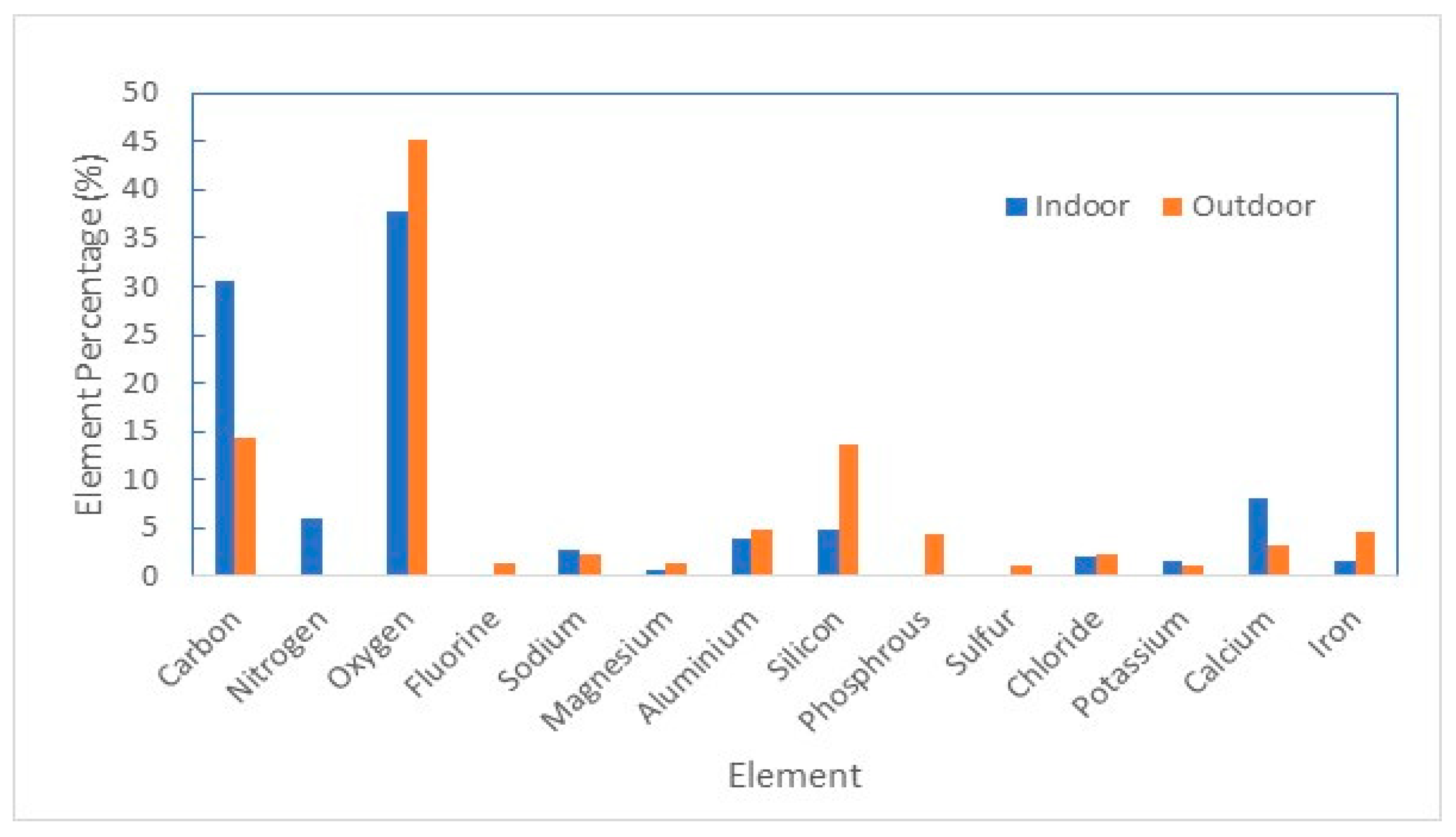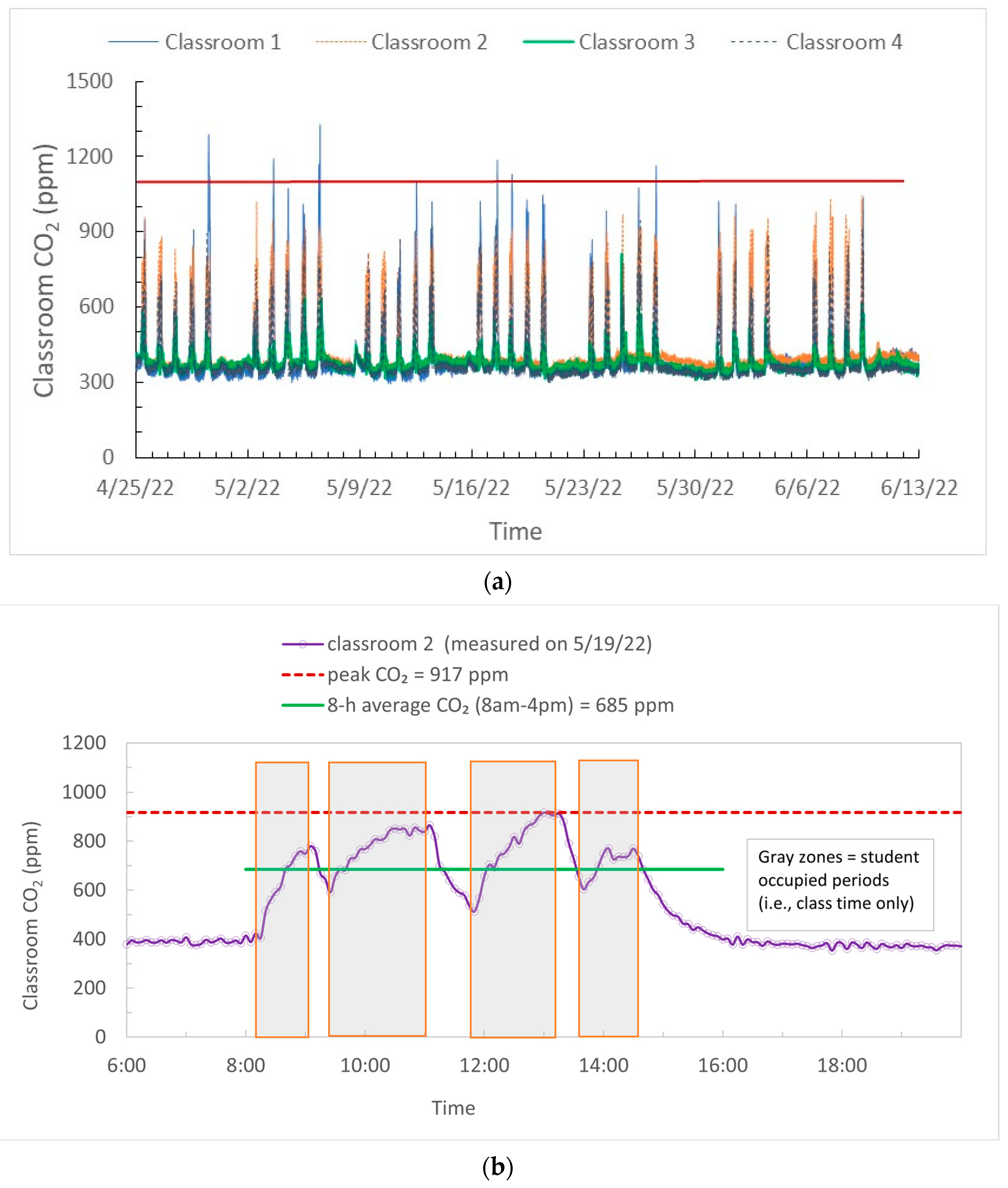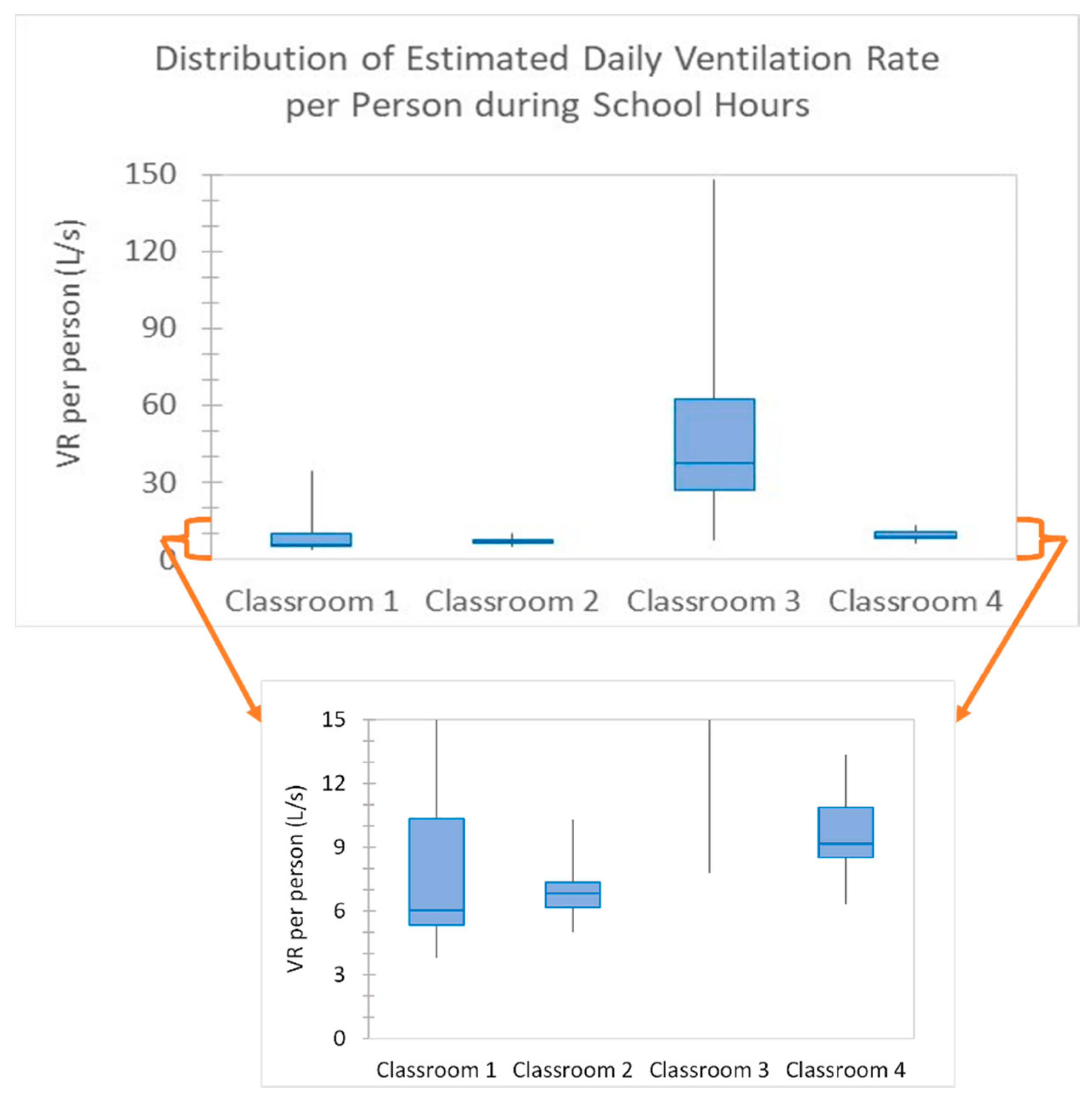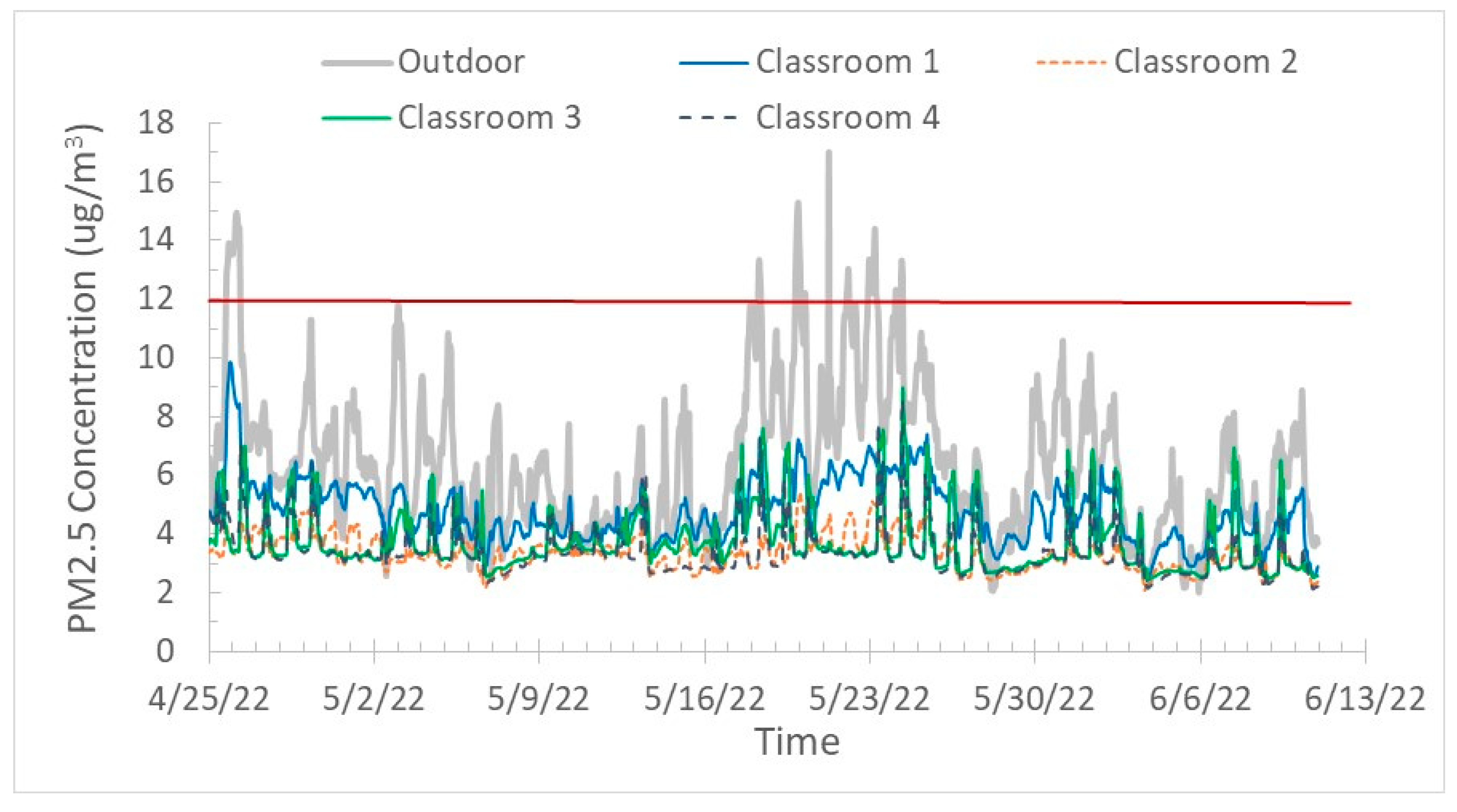Monitoring of Ventilation, Portable Air Cleaner Operation, and Particulate Matter in California Classrooms: A Pilot Study
Abstract
1. Introduction
2. Materials and Methods
2.1. Classroom Selection
- Elementary classrooms usually have a fixed group and number of students, which implies a more consistent total generation rate of CO2 and allows for more accurate estimation of daily VRs from CO2 measurements.
- Having classrooms of the same mechanical ventilation system design and floor plans and within the same building helps to minimize the effects of variation in these factors on IAQ measurement results. The remaining influencing factors are mainly related to operational behaviors (e.g., HVAC maintenance and operation by school facility workers; classroom PAC operation, thermostat setting, and window/door opening by teachers), which were not altered in this observational study.
2.2. Classroom Characterization and Occupancy
2.3. Portable Air Cleaner Characteristics
2.4. Air Sampling and Monitoring of Indoor Environmental Parameters
2.4.1. Real-Time Measurements and Instruments/Sensors
2.4.2. Open-Face Passive Aerosol Samplers
2.5. Estimation of Daily Average Outdoor Air Ventilation Rate (VR)
- The classroom can be reasonably regarded as a well-mixed single zone.
- The number of students, the outdoor VR, and the outdoor CO2 concentration can be approximated as constants during the analysis period.
- The student cumulative occupied hours are sufficiently long and the outdoor VRs are sufficiently high that a true (or near) steady-state can be reached within a school day.
- Q—outdoor air ventilation rate per person (L/s per person).
- G—average CO2 generation rate per person in classroom (L/s per person).
- Css—steady-state CO2 concentration in classroom (ppm).
- Coutdoor—outdoor CO2 concentration (ppm).
2.6. Characterization of Indoor–Outdoor PM Relationships
3. Results
3.1. Classroom PAC Use Pattern
- Continuous operation (i.e., including days/nights/weekends).
- Operation during occupied hours only (i.e., turned on when teacher arrived in the morning and turned off when teacher left in the afternoon).
- Sporadic/random operation with no clear pattern.
3.2. Classroom CO2 Concentrations
3.3. Estimated Classroom Outdoor Air Ventilation Rates (VRs)
3.4. Indoor–Outdoor PM Relationship
3.4.1. PM2.5 Mass Concentration
3.4.2. Qualitative PM Morphology and Elemental Composition
4. Discussion
4.1. Ventilation and Air Quality in the Studied Classrooms
4.2. PAC Operation and Its Impact on Measured Indoor PM
4.3. Uncertainties in Interpreting CO2 Data and Estimating Outdoor Air VRs
4.4. Limitations of the Study
5. Conclusions
Author Contributions
Funding
Institutional Review Board Statement
Informed Consent Statement
Data Availability Statement
Acknowledgments
Conflicts of Interest
Appendix A

References
- Klepeis, N.E.; Nelson, W.C.; Ott, W.R.; Robinson, J.P.; Tsang, A.M.; Switzer, P.; Behar, J.V.; Hern, S.C.; Engelmann, W.H. The National Human Activity Pattern Survey (NHAPS): A resource for assessing exposure to environmental pollutants. J. Expo. Sci. Environ. Epidemiol. 2000, 11, 231–252. [Google Scholar] [CrossRef] [PubMed]
- Landrigan, P.J.; Fuller, R.; Acosta, N.J.R.; Adeyi, O.; Arnold, R.; Basu, N.; Baldé, A.B.; Bertollini, R.; Bose-O’Reilly, S.; Boufford, J.I.; et al. The Lancet Commission on pollution and health. Lancet 2018, 391, 462–512. [Google Scholar] [CrossRef] [PubMed]
- Piscitelli, P.; Miani, A.; Setti, L.; De Gennaro, G.; Rodo, X.; Artinano, B.; Vara, E.; Rancan, L.; Arias, J.; Passarini, F.; et al. The role of outdoor and indoor air quality in the spread of SARS-CoV-2: Overview and recommendations by the research group on COVID-19 and particulate matter (RESCOP commission). Environ. Res. 2022, 211, 113038. [Google Scholar] [CrossRef] [PubMed]
- Peng, Z.; Rojas, A.P.; Kropff, E.; Bahnfleth, W.; Buonanno, G.; Dancer, S.; Kurnitski, J.; Li, Y.; Loomans, M.; Marr, L.; et al. Practical indicators for risk of airborne transmission in shared indoor environments and their application to COVID-19 outbreaks. Environ. Sci. Technol. 2022, 56, 1125–1137. [Google Scholar] [CrossRef] [PubMed]
- CEC. 2022 Building Energy Efficiency Standards. 2019, California Energy Commission. Available online: https://www.energy.ca.gov/programs-and-topics/programs/building-energy-efficiency-standards/2022-building-energy-efficiency (accessed on 10 October 2023).
- State of California, California Education Code-Section 17000-17009.5: Article 1. General Provisions Article 1. General Provisions. 2010. Available online: https://law.justia.com/codes/california/2009/edc/17000-17009.5.html (accessed on 10 October 2023).
- California Department of Industrial Relations. California Code of Regulations: General Requirements of Mechanical Ventilation Systems, in Title 8, Section 5143. 1976. Available online: https://www.dir.ca.gov/title8/5143.html (accessed on 10 October 2023).
- California Department of Industrial Relations. California Code of Regulations: Mechanically Driven Heating, Ventilating and Air Conditioning (HVAC) Systems to Provide Minimum Building Ventilation, in Title 8, Section 5142. 1987. Available online: https://www.dir.ca.gov/title8/5142.html (accessed on 10 October 2023).
- Shendell, D.G.; Winer, A.M.; Weker, R.; Colome, S.D. Evidence of inadequate ventilation in portable classrooms: Results of a pilot study in Los Angeles County. Indoor Air 2004, 14, 154–158. [Google Scholar] [CrossRef] [PubMed]
- Jenkins, P.L.; Phillips, T.J.; Waldman, J.; Environmental Health Conditions in California’s Portable Classroooms, A.R. Board, Editor. 2004. Available online: https://ww2.arb.ca.gov/sites/default/files/2020-05/pcs_r2l.pdf (accessed on 10 October 2023).
- Mendell, M.J.; Eliseeva, E.A.; Davies, M.M.; Spears, M.; Lobscheid, A.; Fisk, W.J.; Apte, M.G. Association of classroom ventilation with reduced illness absence: A prospective study in California elementary schools. Indoor Air 2013, 23, 515–528. [Google Scholar] [CrossRef] [PubMed]
- Chan, W.R.; Li, X.; Singer, B.C.; Pistochini, T.; Vernon, D.; Outcault, S.; Sanguinetti, A.; Modera, M. Ventilation rates in California classrooms: Why many recent HVAC retrofits are not delivering sufficient ventilation. Build. Environ. 2020, 167, 106426. [Google Scholar] [CrossRef]
- The Lancet COVID-19 Commission. Task Force on Safe Work, Safe School, and Safe Travel. 2022. Proposed Non-infectious Air Delivery Rates (NADR) for Reducing Exposure to Airborne Respiratory Infectious Diseases. Available online: https://covid19commission.org/commpub/lancet-covid-commission-tf-report-nov-2022 (accessed on 10 October 2023).
- ASHRAE Standard 241; Control of Infectious Aerosols. American Society of Heating, Refrigerating and Air-Conditioning Engineers (ASHRAE): Atlanta, GA, USA, 2023.
- Curtius, J.; Granzin, M.; Schrod, J. Testing mobile air purifiers in a school classroom: Reducing the airborne transmission risk for SARS-CoV-2. Aerosol Sci. Technol. 2021, 55, 586–599. [Google Scholar] [CrossRef]
- Duill, F.F.; Schulz, F.; Jain, A.; Krieger, L.; van Wachem, B.; Beyrau, F. The impact of large mobile air purifiers on aerosol concentration in classrooms and the reduction of airborne transmission of SARS-CoV-2. Int. J. Environ. Res. Public Health 2021, 18, 11523. [Google Scholar] [CrossRef]
- Porto, R.D.; Kunz, M.N.; Pistochini, T.; Corsi, R.L.; Cappa, C.D. Characterizing the performance of a do-it-yourself (DIY) box fan air filter. Aerosol Sci. Technol. 2022, 56, 564–572. [Google Scholar] [CrossRef]
- Joseph, G.; Schramm, P.J.; Vaidyanathan, A.; Breysse, P.; Goodwin, B. Evidence on the Use of Indoor Air Filtration as an Intervention for Wildfire Smoke Pollutant Exposure; Centers for Disease Control and Prevention: Atlanta, GA, USA, 2020. [Google Scholar]
- Carmona, N.; Seto, E.; Gould, T.R.; Rasyid, E.; Shirai, J.H.; Cummings, B.; Hayward, L.; Larson, T.V.; Austin, E. Indoor Air Quality Intervention in Schools: Effectiveness of a Portable HEPA Filter Deployment in Five Schools Impacted by Roadway and Aircraft Pollution Sources. Atmosphere 2022, 13, 1623. [Google Scholar] [CrossRef]
- The Harvard Healthy Buildings Portable Air Cleaner Sizing tool (PACS). Harvard School of Public Health. Available online: https://forhealth.org/tools/portable-air-cleaner-calculator/ (accessed on 10 October 2023).
- Portable Air Cleaner Calculator. University of Washington. Available online: https://ischool.uw.edu/capstone/projects/2021/portable-air-cleaner-calculator (accessed on 10 October 2023).
- Park, J.-H.; Lee, T.J.; Park, M.J.; Oh, H.; Jo, Y.M. Effects of air cleaners and school characteristics on classroom concentrations of particulate matter in 34 elementary schools in Korea. Build. Environ. 2020, 167, 106437. [Google Scholar] [CrossRef] [PubMed]
- Pampati, S.; Rasberry, C.N.; McConnell, L.; Timpe, Z.; Lee, S.; Spencer, P.; Moore, S.; Mead, K.R.; Murray, C.C.; Deng, X.; et al. Ventilation Improvement Strategies Among K–12 Public Schools—The National School COVID-19 Prevention Study, United States, February 14–March 27, 2022. MMWR. Morb. Mortal. Wkly. Rep. 2022, 71, 770–775. [Google Scholar] [CrossRef] [PubMed]
- de Mesquita, P.J.B.; Chan, W.R.; Heming, A.; Shannon, C. Managing Air Quality during the Pandemic: How K-12 Schools Addressed Air Quality in the Second Year of COVID-19. 2022. Available online: https://www.usgbc.org/resources/managing-air-quality-during-pandemic-how-k-12-schools-addressed-air-quality-second-year (accessed on 10 October 2023).
- ASTM D6245-18; Standard Guide for Using Indoor Carbon Dioxide Concentrations to Evaluate Indoor Air Quality and Ventilation. American Society for Testing and Materials (ASTM): West Conshohocken, PA, USA, 2018.
- Wang, Z.-M.; Zhou, Y.; Gaspar, F.W.; Bradman, A. Using low cost open-face passive samplers to sample PM concentration and elemental composition in childcare facilities. Environ. Sci. Process. Impacts 2020, 22, 1502–1513. [Google Scholar] [CrossRef] [PubMed]
- Kabirikopaei, A.; Lau, J. Uncertainty analysis of various CO2-Based tracer-gas methods for estimating seasonal ventilation rates in classrooms with different mechanical systems. Build. Environ. 2020, 179, 107003. [Google Scholar] [CrossRef]
- Andamon, M.M.; Rajagopalan, P.; Woo, J. Evaluation of ventilation in Australian school classrooms using long-term indoor CO2 concentration measurements. Build. Environ. 2023, 237, 110313. [Google Scholar] [CrossRef]
- Ding, E.; Zhang, D.; Hamida, A.; García-Sánchez, C.; Jonker, L.; de Boer, A.R.; Bruijning, P.C.; Linde, K.J.; Wouters, I.M.; Bluyssen, P.M. Ventilation and thermal conditions in secondary schools in the Netherlands: Effects of COVID-19 pandemic control and prevention measures. Build. Environ. 2023, 229, 109922. [Google Scholar] [CrossRef] [PubMed]
- Batterman, S. Review and extension of CO2-based methods to determine ventilation rates with application to school classrooms. Int. J. Environ. Res. Public Health 2017, 14, 145. [Google Scholar] [CrossRef]
- Karagulian, F.; Barbiere, M.; Kotsev, A.; Spinelle, L.; Gerboles, M.; Lagler, F.; Redon, N.; Crunaire, S.; Borowiak, A. Review of the Performance of Low-Cost Sensors for Air Quality Monitoring. Atmosphere 2019, 10, 506. [Google Scholar] [CrossRef]
- Wang, Z.; Delp, W.W.; Singer, B.C. Performance of low-cost indoor air quality monitors for PM2.5 and PM10 from residential sources. Build. Environ. 2020, 171, 106654. [Google Scholar] [CrossRef]
- McNeill, V.F.; Corsi, R.; Huffman, J.A.; King, C.; Klein, R.; Lamore, M.; Maeng, D.Y.; Miller, S.L.; Ng, N.L.; Olsiewski, P.; et al. Room-level ventilation in schools and universities. Atmospheric Environ. X 2022, 13, 100152. [Google Scholar] [CrossRef] [PubMed]
- Wagner, J.; Sparks, T.L.; Miller, S.; Chen, W.; Macher, J.M.; Waldman, J.M. Modeling the impacts of physical distancing and other exposure determinants on aerosol transmission. J. Occup. Environ. Hyg. 2021, 18, 495–509. [Google Scholar] [CrossRef] [PubMed]
- Woolner, P.; Hall, E. Noise in schools: A holistic approach to the issue. Int. J. Environ. Res. Public Health 2010, 7, 3255–3269. [Google Scholar] [CrossRef] [PubMed]
- Choe, Y.; Shin, J.-S.; Park, J.; Kim, E.; Oh, N.; Min, K.; Kim, D.; Sung, K.; Cho, M.; Yang, W. Inadequacy of air purifier for indoor air quality improvement in classrooms without external ventilation. Build. Environ. 2021, 207, 108450. [Google Scholar] [CrossRef]
- McCarthy, M.C.; Ludwig, J.F.; Brown, S.G.; Vaughn, D.L.; Roberts, P.T. Filtration effectiveness of HVAC systems at near-roadway schools. Indoor Air 2013, 23, 196–207. [Google Scholar] [CrossRef]
- Zee, S.C.; Strak, M.; Dijkema, M.B.A.; Brunekreef, B.; Janssen, N.A.H. The impact of particle filtration on indoor air quality in a classroom near a highway. Indoor Air 2017, 27, 291–302. [Google Scholar] [CrossRef] [PubMed]
- Martenies, S.E.; Batterman, S.A. Effectiveness of using enhanced filters in schools and homes to reduce indoor exposures to PM2.5 from outdoor sources and subsequent health benefits for children with asthma. Environ. Sci. Technol. 2018, 52, 10767–10776. [Google Scholar] [CrossRef]
- Persily, A. Development and application of an indoor carbon dioxide metric. Indoor Air 2022, 32, e13059. [Google Scholar] [CrossRef]
- Persily, A. Evaluating building IAQ and ventilation with indoor carbon dioxide. ASHRAE Trans. 1997, 103, 193–204. [Google Scholar]







| Parameter | Classroom 1 | Classroom 2 | Classroom 3 | Classroom 4 |
|---|---|---|---|---|
| Room volume a | 260 m3 (9180 ft3) | 260 m3 (9180 ft3) | 260 m3 (9180 ft3) | 260 m3 (9180 ft3) |
| Floor material | Carpet | Carpet | Carpet | Carpet |
| Grade level | 1 | 1 | 2 | 1 |
| Number of students b | 19 (14–19) | 19 (15–19) | 22 (17–22) | 20 (17–20) |
| PAC type/model c | A | B | A | A |
| Ventilation system d | Mechanical, HVAC system | Mechanical, HVAC system | Mechanical, HVAC system | Mechanical, HVAC system |
| HVAC Filter | MERV 13 | MERV 13 | MERV 13 | MERV 13 |
| Total supply air changes per hour during school field visit day(s) (ACH) e | 12.2 | 12.9 ± 0.3 | n/a | 11.8 ± 0.1 |
| Total return air changes per hour during school field visit day(s) (ACH) e | 3.5 | 10.3 ± 0.3 | n/a | 9.5 ± 0.2 |
| PAC Setting Levels a | Power Usage (Watts) b | |||
|---|---|---|---|---|
| Classroom 1 | Classroom 2 | Classroom 3 | Classroom 4 | |
| PAC Model A | PAC Model B | PAC Model A | PAC Model A | |
| Level 1 | 63.1 | 10.7 | 66.1 | 66.1 |
| Level 2 | 76.7 | 20.1 | 80.1 | 80.6 |
| Level 3 | 92.1 | 39.8 | 95.2 | 95.3 |
| Level 4 | 101.8 | 85.0 | 104.7 | 105.1 |
| Parameter Measured a | Instrument/Sensor | Accuracy Specifications |
|---|---|---|
| PAC power usage (watts) | Onset HOBO UX120-018 Plug load datalogger (ONSET, Bourne, MA, USA) | 0.5% up to 14 Amp continuous |
| Indoor PM concentration (µg/m3) b | Clarity Node-S (Clarity, Berkeley, CA, USA) | ±10 µg/m3 from 0 to <100 µg/m3; within ±10% of measured value from 100 µg/m3 to 1000 µg/m3 |
| Outdoor PM concentration (µg/m3) b | Clarity Node-S | |
| Indoor CO2 concentration (ppm) | Onset HOBO MX1102 datalogger (ONSET, Bourne, MA, USA) | CO2: ±50 ppm or ±5% of reading at 25 °C from 0 to 5000 ppm; Temperature: ±0.21 °C from 0° to 50 °C; RH: ±2% from 20% to 80% typical to a maximum of ±4.5% including hysteresis at 25 °C |
| Indoor thermal conditions (temperature, RH) | Onset HOBO MX1102 datalogger |
| Classroom No. | PAC Type | PAC Operation Time | Fan Speed Setting a |
|---|---|---|---|
| Classroom 1 | A | During occupied school hours only b | Level 2 |
| Classroom 2 | B | Sporadic/random operation c | Level 1, 2, or 3 |
| Classroom 3 | A | Mostly continuous 24/7 operation d | Level 4 |
| Classroom 4 | A | Continuous 24/7 operation e | Level 2 or 3 |
Disclaimer/Publisher’s Note: The statements, opinions and data contained in all publications are solely those of the individual author(s) and contributor(s) and not of MDPI and/or the editor(s). MDPI and/or the editor(s) disclaim responsibility for any injury to people or property resulting from any ideas, methods, instructions or products referred to in the content. |
© 2024 by the authors. Licensee MDPI, Basel, Switzerland. This article is an open access article distributed under the terms and conditions of the Creative Commons Attribution (CC BY) license (https://creativecommons.org/licenses/by/4.0/).
Share and Cite
Chen, W.; Wang, Z.-M.; Peerless, K.; Ullman, E.; Mendell, M.J.; Putney, D.; Wagner, J.; Kumagai, K. Monitoring of Ventilation, Portable Air Cleaner Operation, and Particulate Matter in California Classrooms: A Pilot Study. Sustainability 2024, 16, 2052. https://doi.org/10.3390/su16052052
Chen W, Wang Z-M, Peerless K, Ullman E, Mendell MJ, Putney D, Wagner J, Kumagai K. Monitoring of Ventilation, Portable Air Cleaner Operation, and Particulate Matter in California Classrooms: A Pilot Study. Sustainability. 2024; 16(5):2052. https://doi.org/10.3390/su16052052
Chicago/Turabian StyleChen, Wenhao, Zhong-Min Wang, Kyle Peerless, Elon Ullman, Mark J. Mendell, David Putney, Jeff Wagner, and Kazukiyo Kumagai. 2024. "Monitoring of Ventilation, Portable Air Cleaner Operation, and Particulate Matter in California Classrooms: A Pilot Study" Sustainability 16, no. 5: 2052. https://doi.org/10.3390/su16052052
APA StyleChen, W., Wang, Z.-M., Peerless, K., Ullman, E., Mendell, M. J., Putney, D., Wagner, J., & Kumagai, K. (2024). Monitoring of Ventilation, Portable Air Cleaner Operation, and Particulate Matter in California Classrooms: A Pilot Study. Sustainability, 16(5), 2052. https://doi.org/10.3390/su16052052







